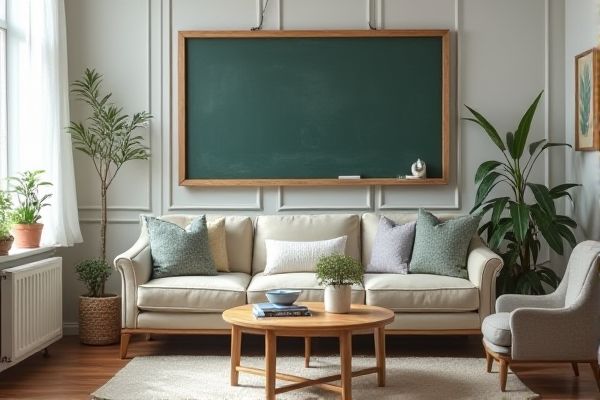
Whiteboards offer a cleaner, more versatile writing surface with easy erasability and compatibility with various markers, whereas chalkboards provide a traditional feel and are often favored for their low cost and tactile chalk experience. Explore the full article to understand which option best suits Your needs and learning environment.
Table of Comparison
| Feature | Whiteboard | Chalkboard |
|---|---|---|
| Writing Surface | Non-porous, glossy surface | Matte, porous slate or painted surface |
| Writing Tools | Dry-erase markers | Chalk sticks |
| Erase Method | Dry eraser or cloth | Chalkboard eraser or wet cloth |
| Dust | Minimal to none | Produces chalk dust |
| Durability | Moderate, sensitive to scratching | High, can be resurfaced |
| Writing Clarity | Bright, visible colors | Less vibrant, limited colors |
| Cost | Higher initial and marker cost | Lower initial, chalk inexpensive |
| Maintenance | Requires regular cleaning to avoid marker stains | Requires occasional resurfacing and cleaning |
| Environmental Impact | Markers contain chemicals, not eco-friendly | Chalk is natural and biodegradable |
Introduction to Whiteboards and Chalkboards
Whiteboards and chalkboards serve as essential tools for visual communication in classrooms and offices, each offering distinct features and benefits. Whiteboards use dry-erase markers for smooth, vibrant writing and easy erasing, while chalkboards rely on chalk that provides a traditional tactile experience with visible dust particles. Choosing between these depends on your needs for ease of maintenance, writing clarity, and environmental considerations in your workspace.
Historical Background and Evolution
Chalkboards, first introduced in the early 19th century, revolutionized classroom teaching by providing a reusable and visible writing surface. Whiteboards emerged in the 1960s as a modern alternative, utilizing erasable markers and offering a cleaner, dust-free option that quickly gained popularity in offices and schools. The evolution from chalkboards to whiteboards reflects advancements in educational tools aimed at improving visibility and ease of use while accommodating changing teaching needs.
Material Composition and Durability
Whiteboards are typically made from materials like melamine, painted steel, or glass, offering a smooth, non-porous surface that resists stains and ghosting, enhancing durability and ease of cleaning. Chalkboards are traditionally composed of slate or a composite material with a rougher texture that can wear down over time and is more prone to dust and surface damage. The longevity of whiteboards generally surpasses chalkboards due to their resistance to scratches and moisture, making them a more durable choice for long-term use.
Writing Experience and Visual Clarity
Whiteboards provide a smooth writing experience with markers that glide effortlessly, producing bright, vibrant colors that enhance visual clarity. Chalkboards offer a tactile feel with chalk, but the dust can blur visibility and reduce sharpness over time. Your choice impacts ease of writing and how clearly information is communicated to your audience.
Maintenance and Cleaning Requirements
Whiteboards require regular wiping with a dry or damp cloth to prevent marker residue buildup, while chalkboards need frequent dusting to avoid chalk dust accumulation. Cleaning whiteboards with specialized solutions helps maintain a smooth writing surface and prolongs marker lifespan, whereas chalkboards often require more intensive cleaning with water and a scrubber to remove stubborn chalk marks. Maintenance of whiteboards is generally easier and less messy compared to chalkboards, making them a preferred choice in modern educational and office settings.
Cost Comparison and Accessibility
Whiteboards generally have a higher initial cost compared to chalkboards due to materials like melamine or porcelain, but they require less maintenance and no chalk, reducing long-term expenses. Chalkboards are more affordable upfront and widely accessible, especially in resource-limited educational settings, but they necessitate regular cleaning and replacement of chalk, increasing ongoing costs. Accessibility favors whiteboards for individuals with respiratory issues, as they eliminate dust inhalation associated with chalk use.
Environmental Impact and Sustainability
Whiteboards offer a lower environmental impact compared to chalkboards due to reduced dust emissions and longer lifespan materials. Chalkboards require frequent cleaning with water and generate chalk dust, which can contribute to indoor air pollution. Sustainable practices favor whiteboards made from recyclable materials and the use of eco-friendly markers to minimize waste and toxicity.
Suitability for Modern Classrooms
Whiteboards offer superior suitability for modern classrooms due to their compatibility with digital tools such as projectors and interactive pens, enhancing multimedia presentations and collaborative learning. Unlike chalkboards, whiteboards produce less dust, contributing to a healthier environment and require minimal maintenance, which aligns with contemporary standards for classroom hygiene and efficiency. The adaptability of whiteboards supports dynamic teaching methods and incorporates technology seamlessly, making them a preferred choice in technologically advanced educational settings.
User Preferences and Ergonomics
User preferences for whiteboards versus chalkboards often hinge on ergonomics and ease of use, with whiteboards offering smoother writing surfaces and less dust exposure, enhancing comfort for prolonged writing sessions. Whiteboards allow the use of various colored markers that can improve visual clarity and engagement, while chalkboards may cause chalk dust allergies and require more physical effort to erase. Your choice should consider factors like maintenance, visual appeal, and health implications to optimize your workspace efficiency.
Final Verdict: Choosing the Right Board
Whiteboards offer a cleaner, more modern writing surface that's ideal for digital integration and frequent use, making them perfect for most classrooms and offices. Chalkboards provide a classic, cost-effective option with less glare but require more maintenance and can create dust. Your choice depends on the setting's needs, budget, and whether you prioritize ease of use or traditional aesthetics.
 homyna.com
homyna.com